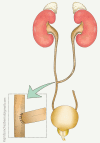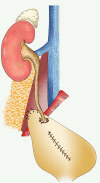A review of ureteral injuries after external trauma
- PMID: 20128905
- PMCID: PMC2830948
- DOI: 10.1186/1757-7241-18-6
A review of ureteral injuries after external trauma
Abstract
Introduction: Ureteral trauma is rare, accounting for less than 1% of all urologic traumas. However, a missed ureteral injury can result in significant morbidity and mortality. The purpose of this article is to review the literature since 1961 with the primary objective to present the largest medical literature review, to date, regarding ureteral trauma. Several anatomic and physiologic considerations are paramount regarding ureteral injuries management.
Literature review: Eighty-one articles pertaining to traumatic ureteral injuries were reviewed. Data from these studies were compiled and analyzed. The majority of the study population was young males. The proximal ureter was the most frequently injured portion. Associated injuries were present in 90.4% of patients. Admission urinalysis demonstrated hematuria in only 44.4% patients. Intravenous ureterogram (IVU) failed to diagnose ureteral injuries either upon admission or in the operating room in 42.8% of cases. Ureteroureterostomy, with or without indwelling stent, was the surgical procedure of choice for both trauma surgeons and urologists (59%). Complications occurred in 36.2% of cases. The mortality rate was 17%.
Conclusion: The mechanism for ureteral injuries in adults is more commonly penetrating than blunt. The upper third of the ureter is more often injured than the middle and lower thirds. Associated injuries are frequently present. CT scan and retrograde pyelography accurately identify ureteral injuries when performed together. Ureteroureterostomy, with or without indwelling stent, is the surgical procedure of choice of both trauma surgeons and urologists alike. Delay in diagnosis is correlated with a poor prognosis.
Figures
References
-
- CDC. FastStats. Atlanta: Centers for Disease Control and Prevention; 2006.
-
- WHO. World Health Statistics 2009. Geneva: World Health Organization; 2009.
-
- WHO. The top 10 causes of death. Genève: World Health Organization; 2009.
-
- Poland A. On rupture of the ureter. Guy's Hospital Reports. 1869;14(85):189–190.
-
- Morris H. Hunterian Lectures - Operations on the ureter. British Medical Journal. 1868;1:873–879. doi: 10.1136/bmj.1.1944.873. - DOI
Publication types
MeSH terms
LinkOut - more resources
Full Text Sources
Other Literature Sources







